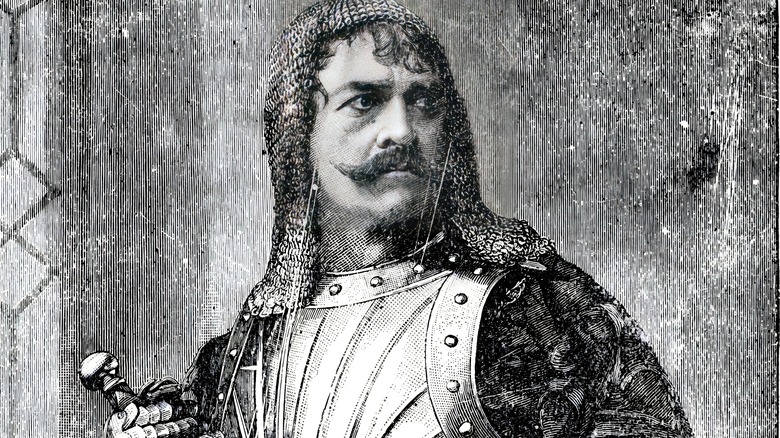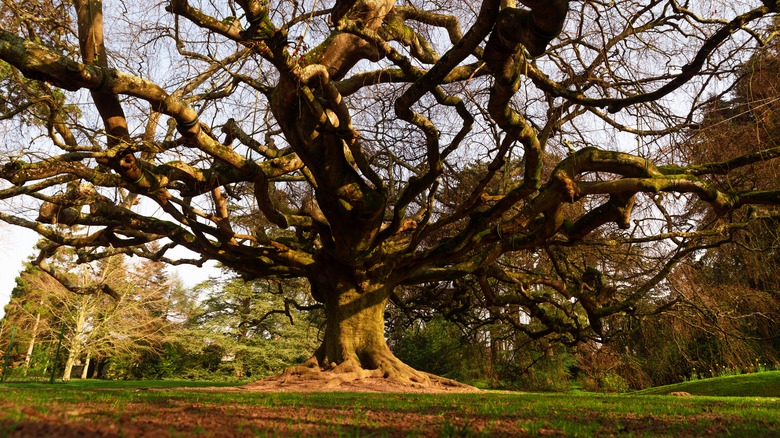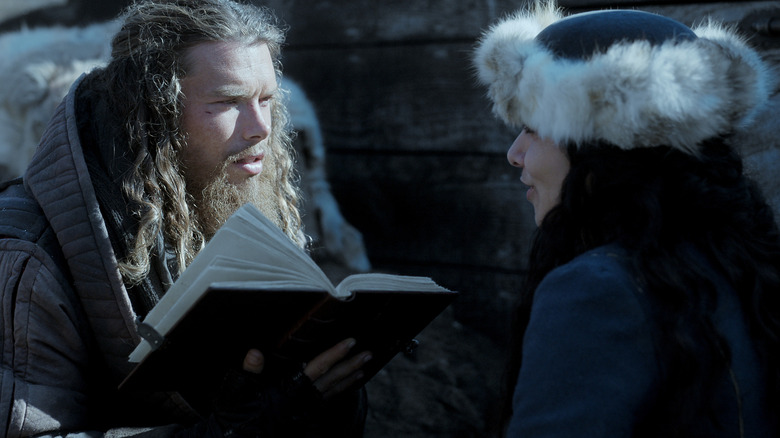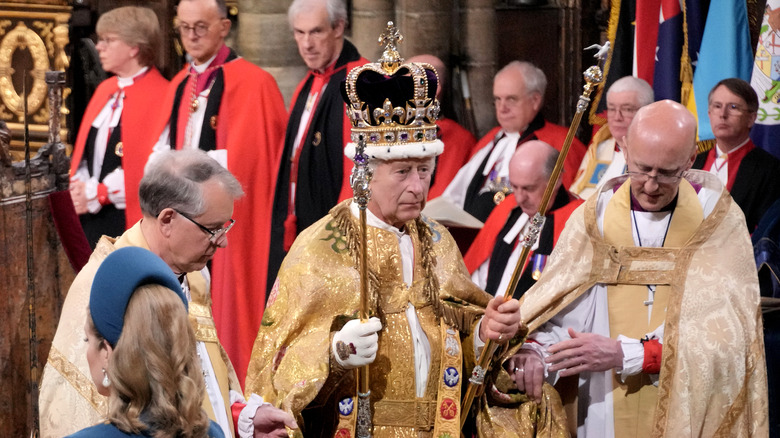Last Kingdom Is Over, & Medieval TV Is Ready For The Rise Of William The Conqueror
On May 6th, the coronation of King Charles III took place at London's Westminster Abbey. For the first time in history — and in a move that some called out of touch — the general public was (initially) asked to join the event and pledge allegiance to the new monarch. It's easy to see why this brand new concept (homage is traditionally paid solely by the king's peers) was wholly at odds with modern democratic ideals: swearing one's personal allegiance to a monarch in a bit of performative feudalism is ... to say the least, a bit antiquated. Yet, however one felt about May 6th's display of tradition and religious pageantry, its controversies pale in comparison to the first coronation ever held at Westminster.
That ceremony took place on Christmas Day in 1066, and the newly anointed monarch at its center, a foreign duke named William, boasts a story that television — particularly in the wake of "The Last Kingdom" — would be remiss to snub. Part of what made "The Last Kingdom" so compelling was its ability to maintain the ambition and excitement of epic narrative while refusing to reduce complex historical figures and conflicts to simplistic caricatures. "The Last Kingdom," like the reality it depicts, is not a story of "heroes" and "villains," but of believably conflicted characters with drastically different motivations and worldviews — one whose very telling asks important, still-relevant questions about how those motivations and worldviews have led us to where we are today. It left behind a thread that William's story might easily pick up: not only is the Norman conquest the logical, chronological next chapter in TV's ongoing love affair with medieval Europe, it's also a narrative with a built-in structural advantage, enormous consequences, and a variety of lenses through which storytellers might view it.
Who is William the Conqueror, exactly?
If one boils the story of William the Conqueror down to its essentials, it looks something like this: in 1066, the death of the English king Edward the Confessor caused a succession crisis. On his deathbed, Edward named his advisor, Earl Harold Godwinson, his successor. This infuriated the duke of Normandy (aka William) who insisted that Edward had named him successor many years prior, and that Harold had sworn an oath to uphold William's claim. Meanwhile, the Norse warrior king Harald Hardrada (yes, that is Harald Sigurdsson, the protagonist of "Vikings: Valhalla"), with the help of Harold Godwinson's estranged brother Tostig, also decided he had a claim to the English throne, owing to a pact that had been made between Edward's predecessor (Cnut's son, King Hardecanute), and Harald's own predecessor, king Magnus I of Norway.
Battles ensued. Harold defeated Harald (and Tostig) at the Battle of Stamford bridge, but his success was short-lived. 19 days later, William defeated Harold at The Battle of Hastings.
William became king, and England — an island that had previously been connected most predominantly to Scandinavia — became part of continental Europe. This set England up to become a major world power, going forward. At the time, though, the English didn't exactly welcome their conqueror with open arms. In fact, William spent a good deal of his reign trying to instill and maintain order, an endeavor that involved everything from violent subjugation, particularly in the north, to political pot sweetening and cooperation.
There is, of course, much more to the story, and many disputing perspectives. First, though, we must begin at the beginning of William's story. Like so many historical figures who've been mythologized over the years, William's origins are the stuff that television dreams are made of.
William's story begins, fittingly enough, with a prophecy
In the late 1020s, a Viking named Cnut sat on the throne of England. Meanwhile, in Normandy — a northern province of (modern-day) France settled by Vikings in the early 10th century — a nobleman named Robert became duke, following the mysterious death of his older brother. Robert never married, and thus, his children were technically bastards. In fact, Robert did not even marry the love of his life, a woman named Herleve (or Herleva) who belonged to a lower social class. Legend claims she was the local tanner's daughter, and Robert's love for Herleve appears to have superseded the young duke's desire to make more pragmatic or political marriage arrangements that would've secured his inheritance.
Around 1028, when Herleve became pregnant with the duke's first child, she had a dream. In it, as William of Malmesbury wrote in 1125, "Her intestines were stretched out, and extended over the whole Normandy and England" (Hickey, p. 20). In two more early 12th-century sources, the imagery is described, rather more poetically, as a giant tree with colossal branches: "It overshadowed the whole of Normandy and the sea and the great English land" (via İslam Kavas' "Trees, Intestines and William the Conquerer").
In the wake of William's conquest of England, his mother's prophetic dream would be used to further justify his actions, and to cement his reputation as a figure of destiny. Oddly enough — and in a turn of events tailor made for prestige TV's affinity for mirroring and parallels, Herleve is not the only character in this story to engage in arboreal prophecy.
The tree prophecies in William's story don't end there
If, in Normandy, our story begins with the fruits of a passionate love affair, in England, it begins with an inconvenient lack of said fruit. That is, it begins with the death of a childless monarch, the last King of the House of Wessex, Edward.
Edward was the son of King Aethelred from the king's (second) marriage to Emma of Normandy — yes, that Emma, portrayed by Laura Berlin in "Vikings: Valhalla." Emma married Cnut following Aethelred's death, and her sons by him were now in competition with both Cnut's sons from his relationship with Aeflgifyu of Northampton, and with the line Aethelred had established via his first marriage. When Edward eventually came to power, it required help from England's most influential nobles, a scheming earl of Wessex named Godwin chief amongst them. Indebted, Edward married Godwin's daughter Edith, and gave Godwin's son — as in, Harold Godwinson — an earldom.
Harold became the king's most loyal advisor, so few Saxons questioned the earl's claim that Edward had named him successor. And yet, the fact remains that he did so (or, didn't so) on his deathbed, and during this time, he also relayed a cryptic dream: As Marc Morris explains in "The Norman Conquest: The Battle of Hastings and the Fall of Anglo-Saxon England," the dying king envisioned two monks warning him that "Within a year of [his] death, 'devils shall come through all this land with fire and sword and the havoc of war.'" Edward asked when England would be free of God's punishment, and they told him this would not happen until, "A green tree, cut down in the middle of its trunk [...] shall be joined again to its trunk, by itself and without the hand of man."
A viking, a duke, and an earl walk into a succession crisis
If dueling, prophetic dreams about massive and self-restoring trees weren't enough to convince a network to tackle this tale, its built-in narrative architecture should do the trick. That the succession crisis ushered in by Edward's death gives us three potential rulers is an important element of the story — one that provides a ready-made trifecta of characters and perspectives.
Even the most basic breakdown of England's throne claimants in 1066 has the makings of compelling television. Harold Godwinson's protagonism relies on us believing that Edward did indeed name the earl heir before dying (and maybe he did — or maybe, as some sources suggest, he was manipulated into doing so, or never did so at all). As for Duke William, his protagonism relies on us believing that Edward named him heir well before 1066, and that Harold himself swore, then broke, an oath to honor that decision (and maybe he did — or maybe, as some sources suggest, he did so while in captivity in Normandy). Lastly, there's the wild card, the "last Viking king," Harald Hardrada, whose protagonism relies on us believing that kings can inherit claims that even their predecessor never attempted to make good on ... though, to be fair, this is really not all that different from what Henry V did, albeit more successfully, at the Battle of Agincourt nearly 350 years later.
Clearly, deciding who to vilify and who to glorify would be an important foundational decision for the series. And yet, it barely scratches the surface of the what-ifs, source discrepancies, twists of fate, and can't-knows that accompany William's conquest, never mind all that led up to it.
William's great-great-(great)-grandfather is Rollo from Vikings
Much of what we "know" of William's childhood comes from later sources drawing on the oral traditions of his legend. We do know, however, that he was the great-great-great-grandson of Rollo (yes, that Rollo, portrayed by Clive Standen in "Vikings") and Poppa of Bayeux (not to be confused with Rollo's wife on "Vikings," Morgane Polanski's Princess Gisla). We also know that when William was an infant, his "living-in-sin" father decided to go on pilgrimage at a precarious time. Robert had only just brought Normandy to heel after much tumult and warfare, and would be leaving his duchy and dukedom unprotected. Nevertheless, this was the 11th century, and obtaining absolution by going on pilgrimage to Jerusalem was all the rage. What's more, it's possible he had a dash of fratricide to atone for (see: his elder brother's mysterious death).
Before Robert left Normandy, he had his magnates recognize the illegitimate William as his heir. Unfortunately, before Robert returned to Normandy, he died.
Subsequently, William was just seven years old at the onset of his reign, and while multiple sources claim his life was under constant threat, some of his near-death experiences and cunning young feats are more dramatic and incredible than others. As David C. Douglas notes in 1964's "William the Conquerer," "Later legends inevitably developed that his greatness was immediately recognized, and his future achievements anticipated. But there is no evidence to warrant this supposition." Douglas' seminal work is not simply a retelling or reinterpreting of William's story, but an exhaustive analysis of the subject's longstanding, ever-evolving historiography. In conjunction with William's connection to historical figures with whom TV audiences are now familiar, it's that historiography that makes him an ideal candidate for a historical series.
A William the Conqueror series has big decisions to make
Any writers bold enough to take on William will have some pretty major questions to explore. Was William's claim stronger than Harold's? When and if Harold swore to uphold William's claim, did he do so willingly? How close did Harold come to winning the Battle of Hastings, and to what degree does William owe his victory to Hardrada's distraction, or to sheer, dumb luck, as opposed to military strategy?
It isn't that the series would be in a position to answer these questions definitively. It's that its chosen depiction of events would, necessarily, compel viewers to rethink certain elements of the story they think they know. For example, when "Vikings" wrote Ragnar Lothbrok (Travis Fimmel) as a conflicted and complex protagonist, it engendered a more three-dimensional understanding of him than the simple legendary figure he was widely recognized as beforehand. Likewise, in choosing to give Eliza Butterworth's Lady Aelswith a great deal more depth, agency, and critical influence than the history books ever did, "The Last Kingdom" shattered the long-held mythology that medieval women had no impact on the course of history.
Now, since retellings of William's story have usually focused on the men at its center, any 21st century should find a way to foreground those groups who are often unfairly lost in the margins of history. How much of William's political legacy is owed to his wife Matilda, who reigned and maintained order in Normandy while he remained in England? And Matilda isn't the only woman involved in this story. Nor, for that matter, is Emma of Normandy, who — though her ability to play both sides of the Dane-Saxon equation, as depicted in "Vikings: Valhalla" — inarguably played a major role in the succession crisis itself.
Medieval women should be at the center of a prestige William series
Relevantly — and, ironically, given their general absence from the story — we owe an inordinate amount of our knowledge of the conquest to the artistry (and, perhaps, patronage) of medieval women. We don't know for sure who commissioned the all-important Bayeaux Tapestry — arguably the most important contemporary source on the events of the conquest — but modern scholarship suggests it might have been Edward's wife Edith, who grew to be one of the most powerful nobles in all of England even under William's rule.
As Janina Ramirez notes in "Femina: A New History of the Middle Ages, Through the Women Written Out of It:""Although there are only three women in the main narrative of the tapestry, each of them is representative of the hundreds of others who wielded power and influence. What's more, the images of conquest, triumph and war were brought into existence through the needles of medieval women. We are left with their version of events, and it is one in which women had agency and embroidered their existence onto the canvas of history."
Both Harold and William are represented with equal parts ambiguity and sympathy (if not triumph) in the tapestry's interpretable imagery, and this may well be the result, as Ramirez writes, of Edith's knowledge of the political dramas at hand. Ultimately, one can read any number of more modern books on the subject, consult countless 11th and 12th century sources, and gorge themselves on documentaries and docuseries, and end up with an image of William (as well as one of Harold, Harald, and the conquest in general) that's even less clear than the image they had when they began.
Will the real William the Conqueror please stand up?
There's William the merciless invader, a man who oppressed and devastated the people of England and destroyed huge swathes of its landscape, particularly with his Harrying of the North. Alternatively, there's the brilliant leader and strategist who brought order, castles, and continental power to England. And there's the man himself, and the various legends that accompany his legacy. There's also Harold — the tragic, virtuous hero and defender of England we see in Tony Robinson's "King Harold: The True Story of the Last Anglo-Saxon King."
Underlying all of it, there's this: because the Norman conquest made England a player on the world stage, it's responsible for all that occurred as a result of that power.
The sheer versatility of the English language, and the fact that we have so many different ways of saying the same thing, is a direct result of William's conquest. Many of the words we encounter every day — including the word "encounter" — are French, to a degree that the language of Norman England might best be described as "Franglish." As for that language being forced upon countless peoples through colonization and the slave trade, this too can be traced back to England's 11th century transition. Basically, because it's a major turning point in European history, whatever happens in the series' 11th century in-world will have something to say about its 21st century audience — and about the story we tell ourselves about ourselves. It's the same reason Nicholas Hytner's adaptation of "The Crucible" and Robert Eggers' "The Witch" can speak, with unnerving clarity, to things like McCarthyism and QAnon without ever setting foot in the present day.
With so much at stake, is the story worth the hassle? Yes. In fact, it's worth telling now because of those stakes.
Complex stories, like that of William the Conqueror, are the ones worth telling
All of these Williams (and Harolds, Saxons, and Normans), and all the narratives they promote, are at once inadequate and relevant, partially true and partially fictitious. That's how history works. There are things we know, things we don't, and things we can't, and all demand constant reevaluation. A 12th century Anglo-Norman could not have the same understanding of events that a historian writing in the 21st century has. For starters, they don't have the benefit of distance, centuries of consequence, and the hyper-connectivity of various fields of study made possible by the internet. And there is, as always, the problem of the victors' history.
This is why seeing these stories play out in emotional, dramatic, vivid, and nuanced fashion is so important. Shield walls, romance, political intrigue, and epic battles are all very fun, but their depiction also complicates, humanizes, and makes history accessible to a wider audience than a prohibitively costly college course. And at a time when the notion of history as a fixed, unimpeachable narrative — one meant more to reassure and reinforce than to inform, remind, and reveal — is growing ever more attractive to some, the virtue of that accessibility is more apparent than ever.
As Megan O'Grady wrote for The New York Times, "As visions of the future increasingly fail in the face of our present moment, literary authors are increasingly looking back, not to comfort us with a sense of known past, or even an easy allegory of the present, but instead — motivated by a kind of clue-gathering — to seek reasons for why we are the way we are and how we got here [...] In our days of sloganeering and apocryphal tweets, it's also a form of resistance."
A William the Conqueror series has so much to say about the 21st century
As Douglas reminds us, "[William] has been presented in terms of Whig theory, of sectarian fervour, and of modern nationalism. He has been hailed as one of the founders of English greatness, and as the cause of one of the most lamentable of English defeats. He has been pictured as the special enemy of protestantism, and as one of the most strenuous opponents of the papacy. He has been envisaged as both the author, and also as the subverter, of the English Constitution. In France, too, the tradition, though distinct, has not been dissimilar."
Like so many other figures who conjure up powerful but often contradictory images based on the lens of their depiction, William embodies the fact that there is no finality in history. Our understanding of the past is forever fluid. The last-minute change that was made to King Charles III's coronation oath ("I now invite those who wish to offer their support..." the wording ultimately began), as well as some of the other updates to the event (e.g., its inclusion of female bishops and Buddhist, Hindu, Jewish, Muslim and Sikh religious leaders, per AP) are all the result of society's necessary rethinking of longstanding narratives, traditions, and perspectives. The crown placed on his head — the crown of St. Edward the Confessor — harkens back to William's coronation in 1066, and is as good a reminder as any that the events of that year are inextricably linked to so many of our modern conflicts and debates.
Surely, an accessible, gripping, and complex exploration of the roots of those conflicts — and of just how far the branches of Herleve's tree have reached into our world today — is worthy of dramatic examination.










